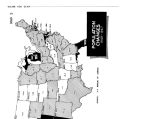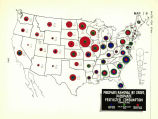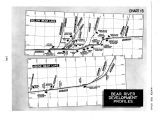| OCR Text |
Show WATER FOR UTAH MORE LAND ... MORE FOOD.. MORE OPPORTUNITY ... The Nation ... The Nation's 429,000,000 acres of good crop, pasture and range lands must be extended by irrigation, drainage and clearing. They must be safeguarded by greater soil conservation, better farm practices and increased applications of commercial fertilizer. But whatever reserves may exist can be readily absorbed by the estimated increase of 10,000,000 people by I960. The need is urgent, therefore, to bring new lands into cultivation with the minimum of delay. . . . Utah and the West . . . The Western States must contribute a large portion of the estimated 70,000,000 acres of new cropland which must be brought into national production by 1970. This will be accomplished mainly through irrigation and the provision of supplemental water to existing acres, the production of which can be increased substantially with adequate water supplies. And there again, Utah- with additional water supplies- can make a significant contribution with its potential 607,- 400 acres of new lands to be irrigated and 406,- 800 acres of land requiring supplemental water to be added to its present million acres of productive areas. By bringing new water supplies to the Bonneville Basin in Utah through diversion from the Colorado Basin, the total crop production of the State can be increased 70%. This is due to the fact that the lands and the climate of the Bonneville Basin, given adequate water supplies, are much more favorable to agriculture than those of the Colorado drainage. Water thus diverted will provide maximum crop values per acre. ENERGY . . . BASE FOR INDUSTRY . ... The Nation ... Inasmuch as low- cost energy is a prerequisite to the well- being of civilization, the Nation's concern as to its manifold supplies is justified. No other part of the world consumes so much energy per capita, and all indications point to rapid and continuing increases- in the home, on the farm and in industry. But severe problems have created a growing number of periods of energy stringencies. To overcome this critical situation, all energy resources of the Nation must be conserved and developed to the full and at an uninterrupted rate. For instance, in water- power, there are many millions of kilowatts which can yet be brought into production. These cannot be left for distant years; they must be developed for the immediate future as important supplements to the overall energy production capacity of the United States and, where possible, to conserve oil. Furthermore, this source of energy provides the principal long- range basis for the operation of electroprocess industries, indispensable to modern industry because of the purity and unusual characteristics of their products. . . . Hydro . . . . . . Utah and the West . . . The West possesses over two- thirds of the Nation's water- power yet to be harnessed. Although most of it is in the Pacific Northwest, important percentages will result from the full development of the Upper Colorado River and its feeder streams in Wyoming, Colorado and Utah. Important in this potential development of energy is the fact that it is a by- product of the control of water for the reclamation of agricultural lands in the Colorado and adjacent basins. As Utah achieves the full potential of the Upper Colorado and its tributaries, it will increase its present hydroelectric capacity by almost six times in 1970, and by eleven times in 1990. These approximate potential kilowatts ( 1,122,000 and 1,908,000 respectively) generated at reservoir and storage sites will provide an unexcelled source of revenues to reimburse expenditures for irrigation and water supply- the Jifeblood of the State's future. They will insure the development of industries, thus stabilizing and balancing the State's economy. [ 6] |

















































































































































